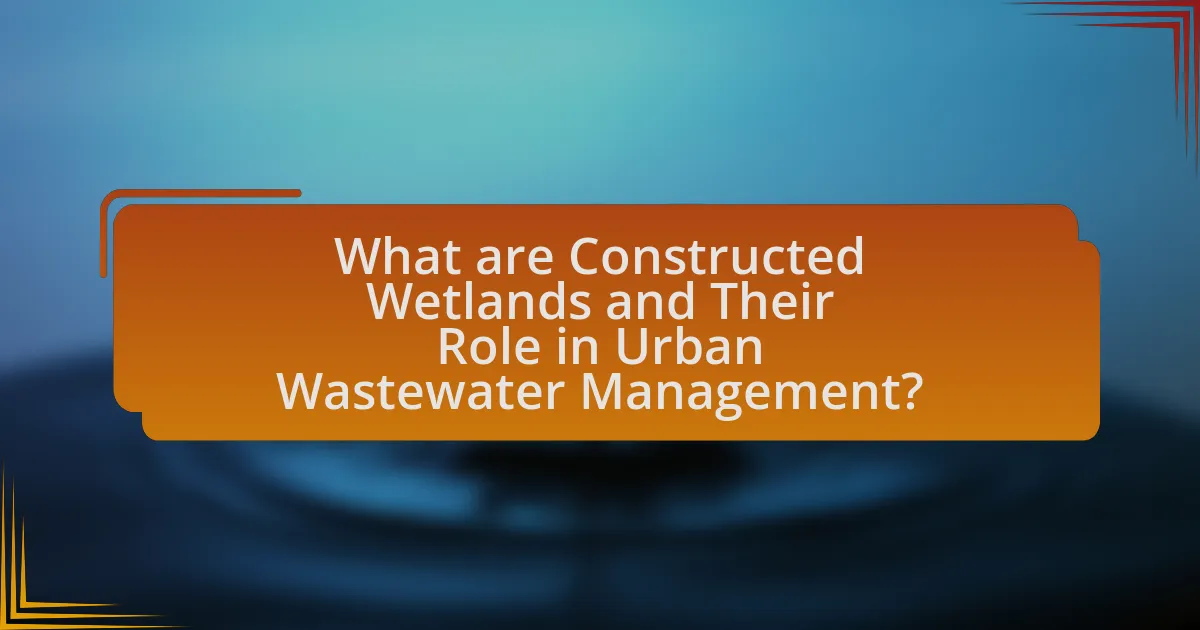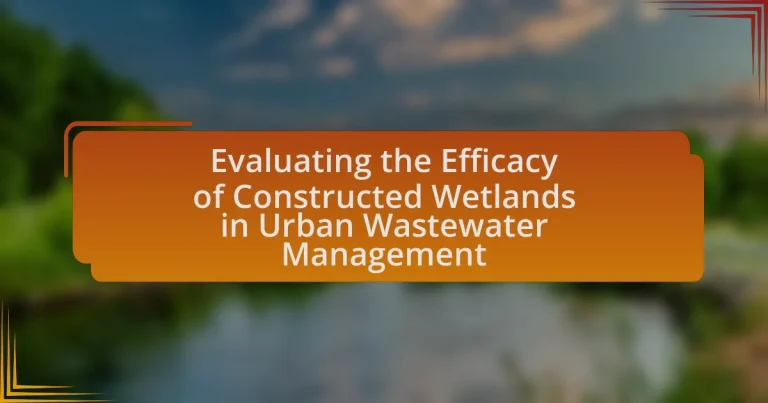Constructed wetlands are engineered systems that replicate natural wetland processes for the treatment of urban wastewater. This article evaluates their efficacy in urban wastewater management, highlighting their ability to remove pollutants such as nutrients, heavy metals, and pathogens with removal efficiencies of up to 90%. It discusses the functioning of constructed wetlands, the advantages they offer in terms of sustainability and economic benefits, and the challenges associated with their implementation. Additionally, it outlines best practices for optimizing their performance and the importance of design considerations in ensuring their effectiveness in urban environments.
What are Constructed Wetlands and Their Role in Urban Wastewater Management?

Constructed wetlands are engineered systems designed to mimic the natural processes of wetlands for the treatment of wastewater. They play a crucial role in urban wastewater management by providing a cost-effective and sustainable method for treating contaminated water, improving water quality, and enhancing biodiversity. Studies have shown that constructed wetlands can effectively remove pollutants such as nutrients, heavy metals, and pathogens, achieving removal efficiencies of up to 90% for certain contaminants. Their integration into urban settings not only addresses wastewater treatment needs but also contributes to stormwater management and habitat creation, making them a valuable asset in sustainable urban planning.
How do Constructed Wetlands function in treating wastewater?
Constructed wetlands function in treating wastewater by utilizing natural processes involving soil, plants, and microorganisms to filter and degrade contaminants. In these systems, wastewater flows through a substrate, typically composed of gravel or soil, where plants such as reeds and cattails provide surface area for microbial growth. These microorganisms break down organic matter and nutrients, while the plants uptake some pollutants, enhancing the overall treatment efficiency. Studies have shown that constructed wetlands can effectively remove up to 90% of suspended solids and significant amounts of nitrogen and phosphorus, making them a viable option for urban wastewater management.
What are the key processes involved in wastewater treatment by Constructed Wetlands?
The key processes involved in wastewater treatment by Constructed Wetlands include physical filtration, biological degradation, and chemical transformation. Physical filtration occurs as water passes through the substrate, removing larger particles and sediments. Biological degradation is facilitated by microorganisms that break down organic matter, while chemical transformation involves processes such as adsorption and nutrient uptake by wetland plants. These processes work synergistically to improve water quality, effectively reducing pollutants such as nitrogen and phosphorus, which are critical in urban wastewater management.
How do different types of Constructed Wetlands vary in their treatment capabilities?
Different types of constructed wetlands vary in their treatment capabilities primarily based on their design, configuration, and the specific pollutants they target. For instance, surface flow wetlands are effective for nutrient removal, particularly nitrogen and phosphorus, due to their exposure to sunlight and aeration, which promote biological processes. In contrast, subsurface flow wetlands excel in removing organic matter and pathogens, as the water flows through a gravel medium that provides filtration and anaerobic conditions conducive to microbial activity. Additionally, hybrid systems that combine features of both types can enhance overall treatment efficiency by leveraging the strengths of each design. Studies have shown that constructed wetlands can achieve removal efficiencies of over 90% for certain contaminants, demonstrating their effectiveness in urban wastewater management.
What are the advantages of using Constructed Wetlands in urban settings?
Constructed wetlands provide multiple advantages in urban settings, primarily in enhancing wastewater treatment efficiency. They effectively remove pollutants such as nutrients, heavy metals, and pathogens through natural processes involving vegetation and microbial activity. Studies indicate that constructed wetlands can achieve up to 90% removal rates for certain contaminants, making them a viable alternative to traditional wastewater treatment systems. Additionally, they contribute to urban biodiversity by creating habitats for various species, improve local aesthetics, and can be integrated into urban landscapes, promoting green infrastructure. Their low operational costs and ability to manage stormwater runoff further underscore their effectiveness in urban wastewater management.
How do Constructed Wetlands contribute to environmental sustainability?
Constructed wetlands contribute to environmental sustainability by effectively treating wastewater while enhancing biodiversity and improving water quality. These systems utilize natural processes involving wetland vegetation, soil, and microorganisms to filter pollutants, thereby reducing the need for chemical treatments. Research indicates that constructed wetlands can remove up to 90% of nutrients like nitrogen and phosphorus from wastewater, which helps prevent eutrophication in nearby water bodies. Additionally, they provide habitat for various species, promoting ecological balance and resilience in urban environments.
What economic benefits do Constructed Wetlands provide for urban areas?
Constructed wetlands provide significant economic benefits for urban areas by reducing wastewater treatment costs and enhancing property values. These systems can lower the expenses associated with traditional wastewater treatment facilities, as they require less energy and maintenance. For instance, a study by the U.S. Environmental Protection Agency found that constructed wetlands can reduce operational costs by up to 50% compared to conventional systems. Additionally, the presence of constructed wetlands can increase nearby property values due to improved aesthetics and environmental quality, with studies indicating that properties adjacent to green infrastructure can see value increases of 5% to 15%.
What challenges are associated with implementing Constructed Wetlands in urban wastewater management?
Implementing Constructed Wetlands in urban wastewater management faces several challenges, including land availability, regulatory hurdles, and public perception. Land availability is critical, as urban areas often have limited space for large-scale wetland systems, which can restrict their implementation. Regulatory hurdles arise from the need to comply with various environmental and zoning laws, which can complicate the approval process. Additionally, public perception can be a barrier; communities may have misconceptions about the aesthetics and functionality of constructed wetlands, leading to resistance against their establishment. These challenges can hinder the effective integration of constructed wetlands into urban wastewater management systems.
What are the common operational challenges faced by Constructed Wetlands?
Common operational challenges faced by constructed wetlands include maintenance issues, variability in wastewater quality, and potential for clogging. Maintenance is crucial as constructed wetlands require regular monitoring and management to ensure optimal performance; neglect can lead to reduced efficiency. Variability in wastewater quality can affect the treatment process, as fluctuations in pollutant concentrations may overwhelm the system’s capacity. Clogging, often caused by the accumulation of organic matter and sediment, can hinder water flow and reduce treatment effectiveness, necessitating periodic cleaning and rehabilitation efforts.
How can urban planners address the limitations of Constructed Wetlands?
Urban planners can address the limitations of constructed wetlands by integrating them with other green infrastructure solutions, such as bioswales and permeable pavements, to enhance their effectiveness in urban wastewater management. This integration allows for improved water quality treatment and increased capacity to handle varying flow rates, which is crucial in urban settings where stormwater runoff can be significant. Additionally, planners can conduct thorough site assessments to select appropriate plant species that are more resilient to urban conditions, thereby improving the longevity and functionality of the wetlands. Research indicates that combining constructed wetlands with traditional treatment methods can lead to better overall performance, as evidenced by studies showing that hybrid systems can achieve higher pollutant removal rates compared to standalone constructed wetlands.
How can the efficacy of Constructed Wetlands be evaluated?
The efficacy of Constructed Wetlands can be evaluated through a combination of water quality monitoring, performance metrics, and ecological assessments. Water quality monitoring involves measuring parameters such as nutrient removal rates, biochemical oxygen demand, and pathogen reduction to determine the effectiveness of the wetlands in treating wastewater. Performance metrics, including hydraulic retention time and surface area, provide insights into the design efficiency and operational effectiveness of the wetlands. Ecological assessments, which may include biodiversity indices and habitat evaluations, help gauge the overall health and sustainability of the wetland ecosystem. Studies have shown that these evaluation methods can effectively quantify the performance of Constructed Wetlands in urban wastewater management, demonstrating their capability to improve water quality and support biodiversity.
What metrics are used to assess the performance of Constructed Wetlands?
Constructed wetlands are assessed using metrics such as removal efficiency of pollutants, hydraulic retention time, and biodiversity indices. Removal efficiency quantifies the percentage reduction of contaminants like nitrogen, phosphorus, and suspended solids, which is critical for evaluating treatment effectiveness. Hydraulic retention time measures the duration water remains in the wetland, influencing pollutant degradation. Biodiversity indices assess the variety of plant and animal species present, indicating the ecological health of the wetland. These metrics collectively provide a comprehensive evaluation of constructed wetlands’ performance in urban wastewater management.
How do case studies contribute to understanding the effectiveness of Constructed Wetlands?
Case studies contribute significantly to understanding the effectiveness of constructed wetlands by providing real-world examples of their performance in various contexts. These studies offer empirical data on pollutant removal rates, operational challenges, and maintenance requirements, which are essential for assessing the systems’ efficiency. For instance, a case study conducted in Italy demonstrated that a constructed wetland achieved over 90% removal of nitrogen and phosphorus from wastewater, highlighting its potential for effective nutrient management. Such concrete evidence from case studies allows researchers and practitioners to identify best practices, optimize design parameters, and adapt constructed wetlands to specific environmental conditions, thereby enhancing their overall effectiveness in urban wastewater management.
What best practices should be followed for optimizing Constructed Wetlands in urban environments?
To optimize constructed wetlands in urban environments, it is essential to implement best practices such as selecting appropriate plant species, ensuring proper design and sizing, and maintaining regular monitoring and maintenance. Selecting native and adaptive plant species enhances pollutant uptake and resilience, while proper design and sizing ensure adequate hydraulic retention time and surface area for effective treatment. Regular monitoring and maintenance, including sediment removal and vegetation management, are crucial for sustaining the wetlands’ functionality and efficiency. Studies have shown that these practices significantly improve the performance of constructed wetlands in treating urban wastewater, leading to better water quality outcomes.
How can maintenance practices enhance the performance of Constructed Wetlands?
Maintenance practices can enhance the performance of constructed wetlands by ensuring optimal conditions for pollutant removal and ecosystem health. Regular activities such as vegetation management, sediment removal, and monitoring water quality help maintain the biological and physical processes essential for effective wastewater treatment. For instance, studies have shown that periodic harvesting of emergent vegetation can improve nutrient uptake and prevent overgrowth, which can hinder water flow and treatment efficiency. Additionally, removing accumulated sediments can restore the wetland’s hydraulic capacity, allowing for better water infiltration and filtration. These practices collectively contribute to the longevity and effectiveness of constructed wetlands in urban wastewater management.
What design considerations are crucial for successful implementation of Constructed Wetlands?
Crucial design considerations for the successful implementation of constructed wetlands include site selection, hydrology, vegetation, and maintenance. Site selection must ensure adequate space, appropriate soil types, and proximity to the wastewater source. Hydrology involves designing for proper water flow and retention times to optimize treatment efficiency. Selecting suitable vegetation is essential, as different plant species have varying capacities for nutrient uptake and pollutant removal. Lastly, ongoing maintenance is critical to ensure the system functions effectively over time, including regular monitoring and management of plant health and sediment buildup. These considerations are supported by studies indicating that proper design directly influences the performance and sustainability of constructed wetlands in urban wastewater management.


